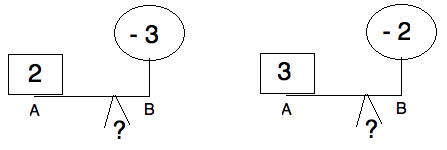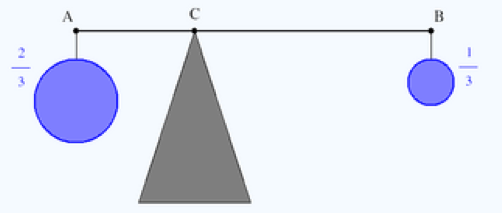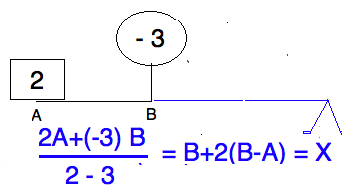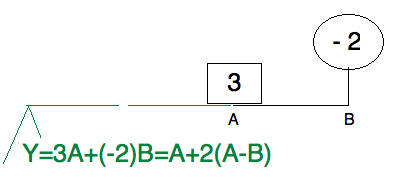Solving Levers with the Teeter-Totter Principle.
9sep10\begin{document}
 \textbf{Question:} Where should the fulcrum be if a weight of $+2$ is
placed at $A$ and a weight of $-3$, a balloon for example, is at $B$?
What if it's $+3, -2$ instead?
\textbf{Solution:}
\subsection{Analyse the known version of this problem}
\textbf{Question:} Where should the fulcrum be if a weight of $+2$ is
placed at $A$ and a weight of $-3$, a balloon for example, is at $B$?
What if it's $+3, -2$ instead?
\textbf{Solution:}
\subsection{Analyse the known version of this problem}
 In the lesson on barycentric coordinates,
the weight $a$ and $A$ and $b$ at $B$ become the coefficients in
$C = \frac{2A+1B}{2+1} = \frac{2}{3}A + \frac{1}{3} B$.
The placement of the fulcrum $C$ is obvious. Substitute a variable for a
constant to conjecture the general rule. Let's use a
$\frac{1}{3} = t$ and write
$ C =_1 A + t(B-A) =_2 A(1-t) + tB . $
Equation 1 places the fulcrum a third of the way from $A$ to $B$.
Equation 2 identifies this point's barycentric coordinates.
\subsection{Generalize and check the validity}
In the lesson on barycentric coordinates,
the weight $a$ and $A$ and $b$ at $B$ become the coefficients in
$C = \frac{2A+1B}{2+1} = \frac{2}{3}A + \frac{1}{3} B$.
The placement of the fulcrum $C$ is obvious. Substitute a variable for a
constant to conjecture the general rule. Let's use a
$\frac{1}{3} = t$ and write
$ C =_1 A + t(B-A) =_2 A(1-t) + tB . $
Equation 1 places the fulcrum a third of the way from $A$ to $B$.
Equation 2 identifies this point's barycentric coordinates.
\subsection{Generalize and check the validity}
 Writing $X = \frac{2A + (-3)B}{2-3}$ leads to rewriting
rewriting $X = A + 2(B-A)$. This places the fulcrum twice
as far from $B$ making $A$ three times as far from the fulcrum.
The lever equation you learned in high school physics becomes
$ 3 \times 2 = 2 \times 3 $.
\subsection{Do it again to make sure.}
Writing $X = \frac{2A + (-3)B}{2-3}$ leads to rewriting
rewriting $X = A + 2(B-A)$. This places the fulcrum twice
as far from $B$ making $A$ three times as far from the fulcrum.
The lever equation you learned in high school physics becomes
$ 3 \times 2 = 2 \times 3 $.
\subsection{Do it again to make sure.}
 Exchanging the weights leads to a surprising result. Following the same
recipe leads to $Y = 3A + (-2)B = A + 2(A-B) $, which places the fulcrum
on the other side. The lever equation remains the same.
\end{document}
Exchanging the weights leads to a surprising result. Following the same
recipe leads to $Y = 3A + (-2)B = A + 2(A-B) $, which places the fulcrum
on the other side. The lever equation remains the same.
\end{document}